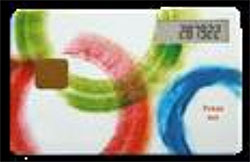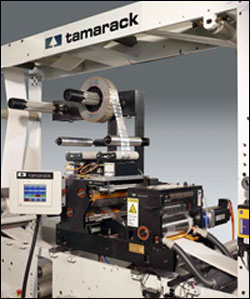May 16, 2013The following are news announcements made during the past week by the following organizations: TracTech Systems; B-Id; GAP Marketing Group; Intermec; and Tamarack Products.
TracTech Systems Unveils New RFID Reader for Inventorying and Tracking Jewelry
TracTech Systems, a provider of RFID-enabled jewelry inventory management technology, has unveiled a new RFID reader that it says is easier to use, more convenient and more functional than its previous models. The new reader, which complies with the ultrahigh-frequency (UHF) EPC Gen 2 RFID standard, offers improved performance over its predecessors, according to TracTech, making scanning jewelry within boxes or non-metal containers easier and more accurate. The interrogator has a built-in processor unit that makes it entirely self-contained, the company reports. Previous versions of the reader had to be connected to an external processor in order to function, the firm adds, but this model builds the processor into the device, making it easier to use, install and transport. The box-shaped reader measures 12 inches by 16 inches by 15 inches and features a larger mouth opening—8 inches high by 14 inches wide by 12¾ inches deep—thereby allowing for greater flexibility in inserting trays and boxes of jewelry. It also features light-emitting diodes (LEDs) to indicate when reads are complete, as well as interior lighting that makes it easy to see jewelry placed within.
B-Id Announces RFID-enabled Display Card for a Variety of Applications
B-Id, an RFID transponder manufacturer and supplier, has announced its SVC Smart Display Card, a passive RFID-enabled plastic display card designed for use in a variety of applications, including transportation cards compliant with the ISO 14443A standard, ID badges compliant with the ISO 15693 standard, prepaid cards, mileage cards, shelf labels and asset labels, among other applications. It features an electronic-paper display, and also has an optional contact chip to show such information as credit value without the use of battery power. The customizable display can show up to eight digits (the default is six). B-Id showcased the new display card at the RFID Journal LIVE! 2013 conference and exhibition, held earlier this month in Orlando, Fla. In addition to this display card, B-Id offers RFID on-metal tags, keyfobs, tokens and wristbands, as well as an RFID reader that support low-frequency (LF), high-frequency (HF) and ultrahigh-frequency (UHF) ISO standards. The company says it can customize solutions so they can be used in industrial and/or extreme operating environments, support various form factors, and combine multiple RFID frequency technologies into a single ISO card.
Manufacturers Point to Tracking as RFID's Strong Suit, Study Shows
A sponsored survey regarding the use of radio frequency identification and bar-coding technologies in the manufacturing sector reveals that organizations believe RFID generates the greatest benefit when used for very specific applications, such as inventory tracking. GAP Marketing Group conducted the study in March 2013, on behalf of Entigral Systems, Motorola and Smartrac, and queried several midsize discrete and process manufacturers. A majority of respondents (67 percent) reported they are familiar with RFID technology. However, only a quarter of the respondents' companies are actually using RFID at present. Nearly half (48 percent) agree that the technology can do things for companies that bar-coding cannot. Of the primary benefits of RFID, which were ranked in order by respondents, accuracy made the top of the list, followed by the ability to read at a distance and then the ability to read without visual contact. Barriers to adoption cited include a lack of understanding (20 percent) and costs (17 percent indicated they lack the budget to support RFID, while 18 percent said RFID was too expensive). Eleven percent replied that they did not have internal support for RFID, and 13 percent said they believe there is no perceived need for the technology. When asked which issues their companies are experiencing, respondents cited tracking inventory and work-in-progress as the top concerns. Inventory tracking was chosen as the most beneficial of RFID for companies, followed by manufacturing process control and warehouse tracking. Of those respondents whose companies are using or planning to utilize RFID for tracking, 14 percent are using it to track individual inventory items, 12 percent for in-process inventory, 7 percent for raw materials, 7 percent for fixed assets, and 6 percent to track containers (39 percent responded that they are not using RFID). Long-range reads of 10 to 20 feet garnered the most votes as an important characteristic for RFID readers, and handheld readers received the most votes as the device type most likely to be used. Seventy-two percent of respondents said they currently employ bar codes, but one-third of them indicated that the technology falls short of meeting some of their needs.
Intermec Opens New Design and Test Facility
Intermec has announced the opening of a new technology center—a $12.5 million, two-story, 81,000-square-foot facility housing the company's design and testing initiatives. The building, located at 601 Third St. SE, in downtown Cedar Rapids, Iowa, replaces the company's existing facility at 550 Second St. SE. The total investment for the project was $28 million, the firm reports. Nearly 220 employees work at the Cedar Rapids facility (Intermec itself has more than 2,300 employees globally), and of those 220, approximately 80 percent focus on research and development (R&D) and the design of Intermec's technologies. The new facility features an open floor plan, collaborative work areas and more than 12,000 square feet of electrical, mechanical, software and RF test labs.
Tamarack Intros New RFID Inlay Affixing System
Tamarack Products, which provides solutions to produce RFID labels, tags and tickets, has introduced an RFID inlay affixing system that the company calls a lower-cost version of its commercially available P500 RFID inlay. The lower cost of the P300 version is accomplished by allowing for a narrower width and simpler design, according to the company. The P300 RFID inserts inlays onto a web of label or tag stock, by automatically feeding the inlays into the system, scanning them and then accurately cutting between antenna patterns and applying the inlays into the web using a vacuum cylinder. For RFID label production, the label web is printed and then delaminated, and the P300 inserts the inlay onto the label facestock. The liner receives a pattern of hot-melt adhesive that will transfer to the inlay when the liner and facestock are relaminated. For RFID tickets and apparel tags, the press feeds two paper webs. Each web is printed; one is coated with hot-melt adhesive and receives the inlay, while the other is coated with a pattern of hot-melt adhesive that contacts the inlay when the two paper webs are laminated. To finish the labels tickets or tags, LineLogix RFID equipment provided by GlueLogix reads, encodes and marks the laminated web. The web is then folded, sheeted or rewound in the press-finishing section. According to Tamarack, all of the operations are completed during a single pass through the press, thereby providing a finished RFID product with less handling, waste and process time than with competing off-line approaches. Tamarack reports that it can integrate the P300 RFID equipment into any organization's press, and can custom-tailor a complete installation to meet individual needs. Multi-lane systems, reading and encoding options, ink-jet printing and wet-inlay solutions are also available.



